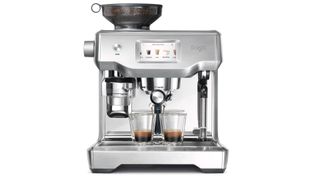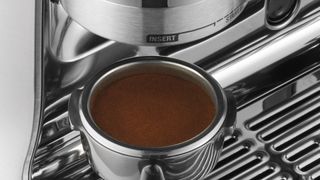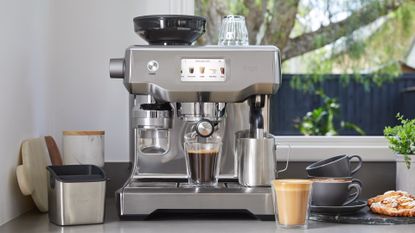If you want the short version of our Sage The Oracle Touch review, it's probably the best coffee maker you can buy for domestic use, and certainly the best premium bean-to-cup coffee machines.
There are numerous ways to brew a coffee but, for true aficionados, using the best espresso machine the most satisfying way to enjoy the fruits of the humble bean. But which type of espresso extraction is best for you? A decent quality manual espresso machine will certainly do the job well but they’re not always consistent and the whole process of grinding the beans and spooning the results into the portafilter is messy and labour intensive.
One very popular alternative is the best pod coffee machine. These also serve up espresso but are much easier to use – just drop a pod in the chamber and press a button – and most of them produce very consistent results that are surprisingly rich in flavour and with excellent crema (the creamy caramel-coloured topping on every good espresso).
However, in between these two extremes of convenience (or lack of it) are bean-to-cup. While not as practical or as tidy as a capsule-based model, bean-to-cup machines take the general palaver out of preparing espresso. You simply pre-load a hopper with beans, select your style of brew (espresso, latte, etc) and a minute or two later a single shot espresso (or whatever you’ve requested) is delivered to you on a tray by a tall, handsome Italian gentleman (well maybe not that last bit).
Finally there is this: a hybrid machine from Sage/Breville – see below – that straddles the space between a bean-to-cup and a traditional espresso machine.
Sage Oracle Touch: price and availability
The Oracle Touch is sold under the Sage brand in the UK and Europe, but is known as the Breville Oracle Touch in the rest of the world, for reasons too boring to go into here. Official pricing is as follows: £2,099.95 in the UK; $2,799.95 in the USA and AU$3,799 in Australia. Crikey.
The good news is that, as the Oracle Touch has been on sale for a number of years now, you do increasingly see it on sale at Amazon and elsewhere. It's still a premium item, however.
Sage Oracle Touch: design and features

Sage Oracle Touch - a mighty friend of the bean
This machine is big. As in 'bloody-hell-where-are-we-going-to-put-the-kettle-now?' big. Measuring a substantial 39.2cm in width, 37.3cm in depth and 45.4cm in height, the Oracle Touch is truly gargantuan and seriously heavy, too. Which leads us to a brilliant feature that has nothing to do with making coffee.
Underneath the large stainless steel overflow tray there’s a circular plastic knob. Turn it and the whole machine lifts up on to a set of hidden mini caster wheels. Now you can move the whole machine freely about the worktop without giving yourself a hernia. Once back in position, simply turn the knob again and the whole shebang sits solid on the worktop again. This is just the type of hidden detail we love. While we’re under the bonnet, as it were, the same space also contains a handy little drawer for storing the cleaning tools and a spare portafilter insert.
Despite the weight of this beast, most of the machine is clad in heavy-duty plastic. Personally, this writer would have preferred a full metal jacket but at least the cladding looks like metal.
Moving to the top of the machine, there’s a twist-in coffee bean hopper big enough to swallow 280 grams of fresh beans and, just to the front of it, a convenient water filling portal. Alternatively, you can reach round the back and pull out the entire water reservoir – with integral replaceable water filter – which holds a substantial 2.5 litres.
The machine comes with one heavyweight portafilter, two push-in filter baskets (single shot and double shot), a stainless steel milk frothing jug and a metal-clad ‘knock box’ to release the used grounds from the portafilter. It also comes with a few cleaning tools, a clip-in water filter and an instruction manual that could be a bit more clearly written.
Sage Oracle Touch: the preparation process

The Oracle Touch automatically tamps the coffee in preparation for brewing
The Oracle Touch’s touchscreen LCD interface is the heart of the system and features six main automatic brewing options - espresso, long black, latte, flat white, cappuccino and hot milk – and eight customisable settings that family members can individually name.
The process of making a coffee couldn’t easier. Simply swipe your finger along the scrolling list and choose your preferred style of coffee. Now clip the empty portafilter into the grind outlet on the left hand side and either tap ‘grind’ on the screen or push the handle to the right. The machine will proceed to grind the beans and then cleverly deposit the powdered coffee into the portafilter before tamping it down to a perfect consistency ready for brewing. It should be noted that the noise it makes while performing this process is extremely irritating and loud (think one hundred squeaking mice scratching their claws on a chalkboard at the same time).
The next stage is to remove the portafilter from the grinding mechanism and twist it into the the actual coffee extraction chamber (or group head, to use the correct term) to its right. The portafilter itself is designed for dispensing two cups at a time so make sure to place any single espresso cup accurately beneath or some of the black gold will miss the cup entirely. Thankfully, the two streams of liquid taper inwards a bit so even the narrowest of espresso cups should receive a full dose without any spillage.
Finally, select ‘single’ or ‘double’, press the ‘brew’ button on the screen and the machine will extract a perfect espresso replete with obligatory crema. The single-shot extraction time is preset at 25 seconds but this can be increased in custom settings. Alternatively, you can press the same brew button to stop it or press it again for a longer extraction.

Frothing milk is a cinch with the Oracle Touch
Making a cappuccino or latte is just as easy. Simply fill the supplied stainless steel jug with milk and place it under the wand. Rather cleverly, the machine is capable of frothing milk and extracting espresso at the same time. While it didn’t make the silkiest froth (it was a bit too bubbly for my liking), it was more than adequate.
Sage Oracle Touch: the taste test
If you like a really strong barista-style caffeine hit then this is the machine for you. This writer has never been enamoured of the bean-to-cup method because the results have rarely been strong enough, even when using the finest ground setting. This machine features 45 grind size settings so, with this in mind, I ignored Sage’s recommendation to select option 30 and, using a standard Lavazza blend, went for a number 5 grind instead. Big mistake – it was so strong and bitter I almost gagged. Lesson learned, I hastily changed the grind setting to a more modest 27 and the result was perfection – rich, creamy and with the same level of bite and aroma one gets at a barista bar.
Incidentally, if you’re looking for a widely available coffee bean blend that imparts a deliciously nutty and fulsome flavour with a faint hint of chocolate then check out Marks & Spencer’s No 5 Strength Peruvian blend. It’s a perfect, keenly-priced bean for a machine like this.
Sage Oracle Touch review: verdict

Despite taking about seven minutes to warm up and the racket it makes when grinding the beans, the Sage Oracle Touch is a worthwhile espresso and cappuccino maker for those who insist on the authenticity of a manual machine but don’t fancy the idea of cleaning up afterwards. Yes it’s bloody expensive and yes it is huge, but it’s effortless to use and it produces an exquisite extraction time after time.
Sage’s Oracle Touch takes the faff out of making barista-standard espressos. Granted, there is both considerable expense and a bit of work involved – you will need to move the portafilter from grinder to the group head and empty it afterwards – but everything else from the grinding and tamping to the final extraction and milk frothing process is fully automated.
With six preset coffee styles at your fingertip and up to eight customisable settings, this machine makes consistently excellent espressos.
Sage The Oracle Plus: also consider
As well as the cheaper but in many ways similar bean to cup machines that Sage/Breville itself makes, our top recommends in this category are De'Longhi's latest, range-topping Primadonna machine and the T3 Award-winning Jura E8. They are both easier to use than the Oracle Touch but perhaps less satisfying overall. They are also both a lot cheaper, however, so there is that.




